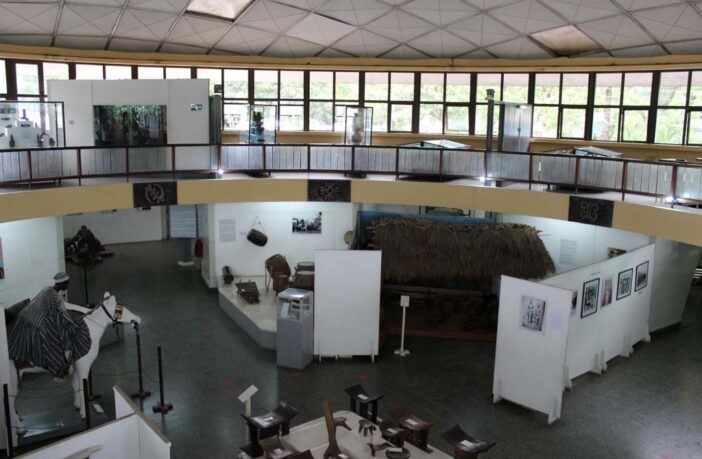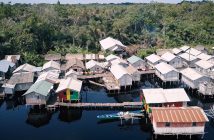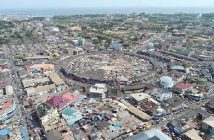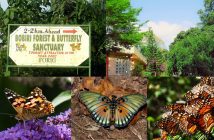The National Museum of Ghana located in the capital of Ghana, Accra, is by far the largest and oldest of the six museums under the administration of the Ghana Museums and Monuments Board (GMMB).
The museum building which was opened on 5th March 1957 as part of Ghana’s independence celebrations, had an official opening performed by the Duchess of Kent, Princess Marina. The Museum’s first Director was A.W. Lawrence.
Objects of archaeology, ethnography as well as fine art can be found in the National Museum building. Objects in the archeology section range from the Stone Age period to the recent historical past.
A day spent in the national museum will enlighten you on the rich Ghanaian culture and its historical background.
Ghana which was formerly known as the Gold Coast, gained independence from the British colonial rule, on the 6th of March, 1957 with Kwame Nkrumah as the leader declaring the country’s independence. On 1 July 1960, Ghana became a commonwealth republic with Nkrumah as the first President of the country. The flag of Ghana consists of the colours red, gold, green, and the black star.
In 1966 its first president and pan-African hero, Kwame Nkrumah, was deposed in a coup, heralding years of mostly-military rule. In 1981 Flight Lieutenant Jerry Rawlings staged his second coup. The country began to move towards economic stability and democracy.
In April 1992 a constitution allowing for a multi-party system was approved in a referendum, ushering in a period of democracy. A well-administered country by regional standards, Ghana is often seen as a model for political and economic reform in Africa.
Ghana over the years through its struggles has emerged as the world’s second largest cocoa producer behind Ivory Coast, and Africa’s biggest gold miner after South Africa. It is one of the continent’s fastest growing economies and has made major progress in the attainment and consolidation of growth. Significant progress has been made in poverty reduction. In fact, Ghana is the first country in Sub-Saharan Africa to achieve the Millenium Development Goal 1, which is the target of halving extreme poverty.
Ghana has recently become a middle income country. The discovery of major offshore oil reserves was announced in June 2007, encouraging expectations of a major economic boost. Production officially began at the end of 2010, but some analysts expressed concern over the country’s ability to manage its new industry, as laws governing the oil sector had not yet been passed.
In July 2009, Ghana secured a 600 million dollar three-year loan from the International Monetary Fund (IMF), amid concerns about the impact of the global recession on poorer countries. The IMF said the Ghanaian economy had proved to be relatively resilient because of the high prices of cocoa and gold. Beside economic development, Ghana has made real progress in good governance, youth and gender empowerment.
Important pieces of relevant legislation have been enacted and institutional arrangements improved to promote inclusive society. Government for instance has enacted the Domestic Violence and Disability Laws, established Domestic Violence Victim Support Units and the implementation of the National Social Protection Strategy.
The Republic of Ghana is named after the medieval West African Ghana Empire. The empire became known in Europe and Arabia as the Ghana Empire after the title of its Emperor, the Ghana. The Empire appears to have broken up following the 1076 conquest by the Almoravid General Abu-Bakr Ibn-Umar. A reduced kingdom continued to exist after Almoravid rule ended, and the kingdom was later incorporated into subsequent Sahelian empires, such as the Mali Empire several centuries later. Geographically, the ancient Ghana Empire was approximately 500 miles (800 km) north and west of the modern state of Ghana, and controlled territories in the area of the Sénégal River and east towards the Niger rivers, in modern Senegal, Mauritania and Mali.
Central Sub-Saharan Africa, agricultural expansion marked the period before 500 AD. Farming began earliest on the southern tips of the Sahara, eventually giving rise to village settlements.Toward the end of the classical era, larger regional kingdoms had formed in West Africa, one of which was the Kingdom of Ghana, north of what is today the nation of Ghana. Before its fall at the beginning of the 10th century Akans migrated southward and founded several nation-states around their matriclans, including the first empire of Bono State founded in the 11th century and for which the Brong-Ahafo (Bono Ahafo) region is named. Later Akan ethnic groups such as the Ashanti empire-kingdom, Akwamu, Akyem, Fante state and others are thought to possibly have roots in the original Bono State settlement at Bono Manso. The Ashanti kingdom’s government operated first as a loose network and eventually as a centralized empire-kingdom with an advanced, highly specialized bureaucracy centred on the capital Kumasi.
Ghana is culturally diverse, with dozens of native tribes and influences from neighboring locations and peoples. Each tribe has its own distinct characteristics and there are different ethnic groups scattered all around the country. Wherever you travel to when you volunteer abroad, look out for tribal events and demonstrations of dancing and ceremonies to witness the varied culture of Ghana firsthand.
Below are some of the tribes.
The Ashantis
Comprising around half of the country’s population, the Ashanti tribe of the Akan is the largest in Ghana. Establishing an empire in 1670, the Ashantis named Kumasi their capital ten years later, and the areas around the city became part of this wealthy and influential empire. Most Ashanti tribe members speak the dialect Twi, either as a first or second language.
The tribe is presided over by a king or queen, who maintains political rule over the Ashanti homeland and people. Centuries after the tribe’s establishment, the Ashantis now number an estimated 11 million people, retaining their wealth as a result of the many contributions the people make to the economy, including agricultural exports like coffee and cocoa, diamonds, timber and industrial minerals.
The Fantes
The Fante are people of southern Ghana who settles along the coast between Accra and Sekondi-Takoradi, especially residing in and around Cape Coast. Migrating from the Techiman region during the 17th century, the tribespeople went on to settle in numerous small states, each of which has its own Fante chief, descended from royalty. Under this main chief are several other more lower-ranking subchiefs.
There are about 2.5 million Fante people in Ghana today, according to estimates, all of whom are descended from twelve patrilineal clans. Each clan has associated family names and most tribespeople speak a dialect of Akan – a Kwa language. Every lineage also has a sacred stool, which forms a key part of traditional ceremonies, believed to hold the spirits of each clan’s ancestors.
The Ewes
Comprising of about 11 per cent of Ghana’s population, the Ewe tribe is one of the best-known throughout the country for its traditional customs and musical nature. Originating in Togo and the Volta region, the Ewe people are primarily fishermen and farmers but have, in more recent years, branched out into weaving and other trades when rainfall has been low.
Ewe tribe members spend a lot of time with extended family – this forms the main social group for many people. Dancing and drumming are a couple of other key characteristics of this tribe, and hunting dances, peace dances and war dances are commonly performed to the beat of drums on special occasions. It is the Ewe belief that if a member of the tribe is a good drummer, they have been filled with the spirit of an ancestor with the same skill.
The Mole-Dagbonians
Mole-Dagbonians account for a seventh of the Ghanaian population, making this tribe the second-most populous in the country. Mainly inhabiting the northern regions of Ghana, where they account for more than 50 per cent of the local population, the Mole Dagbona tribe comprises a number of subgroup tribes, such as the Dagoma and the Mamprusi.
The dominant religion in the northern region is Islam and, as such, there are many beautiful old mosques to be seen around these parts, such as the Larabaga Mosque dating back to the 13th century. Mole-Dagbonians speak a variety of languages depending on the district, with Dagbani, the language of the Dagomba tribe, spoken across nine out of the 13 northern districts. Other tongues include the Gonja language and Kokomba.
The Guang
The people of Guan, live all over Ghana and are believed to have started spreading across the nation more than a thousand years ago. Various subtribes are known to have descended from the Guan people, including the Gonja, who predominantly reside in northern Ghana and make up about a quarter of the Guan population in total.
The Guang are believed to have been the earliest inhabitants of Ghana. Now, the tribe encompasses around 26 ethnic groups. Both Guan dialects and Fante tongues are used by many of the tribal subgroups. Some of the subgroups, such as the Gonja, are renowned for their historical prowess as warriors, while the Anum tribe are well-known craftsmen.
Those on permanent exhibition at the ethnography gallery include chief’s regalia, indigenous Ghanaian musical instruments, (the 1950’s Highlife for instance, is a musical genre that originated in Ghana, Sierra Leone and Nigeria, fused African rhythms with western music. The sound, of which there were a few variations, generally combined multiple guitar rhythms with a brass band backing, as well as various percussion instruments.
Its roots can be traced back to the 1880s to the music of marching bands and sailors’ palm wine groups. The term ‘highlife’, which was coined in the 1920s, is thought to be a reference to parties by the European upper-class. Local bands played the musical accompaniment to the lavish events to which people aspired.
Two main forms of highlife had emerged by the middle of the 20th Century. Dance orchestras played at the parties of the elite, while poor, rural musicians played a guitar-orientated version of the music. The guitar-based class of music rose to prominence in the 1950s and became associated with a pre-independence sound as it came to incorporate elements of swing, jazz and Cuban rhythms with the emerging guitar class of West Africa.
During World War II swing was introduced by UK and US servicemen based in Ghana, giving way to smaller highlife bands. Describing this melting pot of sounds, Professor John Collins – a musicologist at the University of Ghana – wrote: “By combining…so-called high-class music with local street tunes, a totally different type of music was born – the highlife we know today.”
This music became the soundtrack to the birth of an independent nation in 1957.During that time trumpeter E.T. Mensah became the most famous proponent of the sound – first with his band The Tempos and later as a solo artist. In the early years of Ghanaian independence the popularity of highlife was maintained. A number of guitar highlife outfits formed following the success of The Tempos, including Nana Ampadu and his band the African Brothers and A.B. Crentsil), gold weights, beads, traditional textiles, stools and pottery.
There are also objects from other African countries acquired through exchange. Examples are Senfu masks from Ivory Coast, Zulu wooden figures and bead-ware from Southern Africa. In addition there are also ancient Ife bronze heads from Nigeria and Bushongo carvings from the Congo. Exhibits at the small but impressive art gallery consist mainly of contemporary Ghanaian paintings executed in oils, pastels, acrylics, watercolours and collages. Apart from these there are sculpture pieces in different media.
REFERENCES
1. Available online at, https://en.m.wikipedia.org/wiki/National_Museum_of_Ghana
2. Available online at, https://www.gh.undp.org/content/ghana/en/home/countryinfo.html
3. Available online at, https://en.m.wikipedia.org/wiki/History_of_Ghana#:~:text=The%20Republic%20of%20Ghana%20is,Abu%2DBakr%20Ibn%2DUmar.
4. Available online at, https://www.uvolunteer.net/blog/getting-know-ghanas-tribes/.





